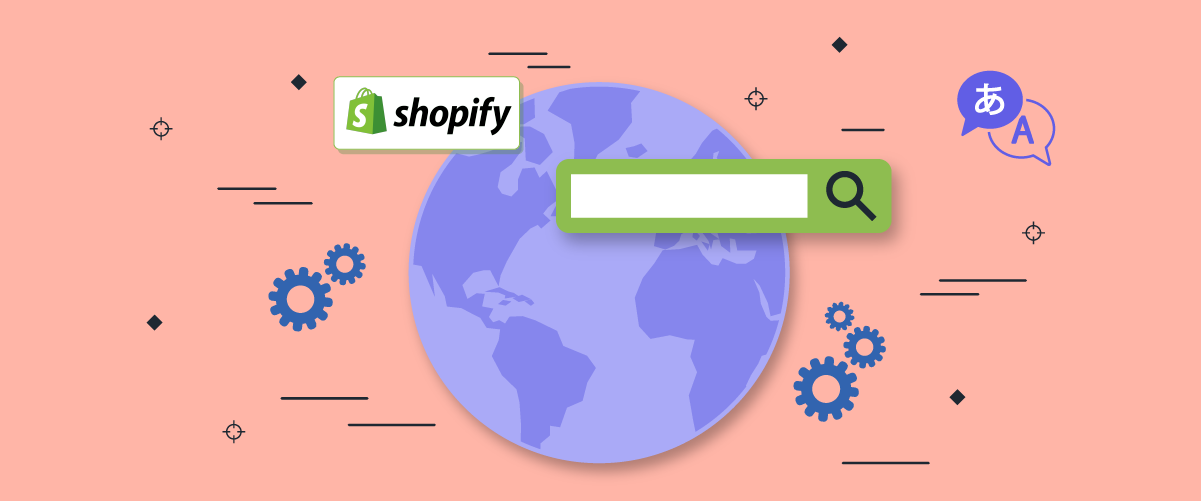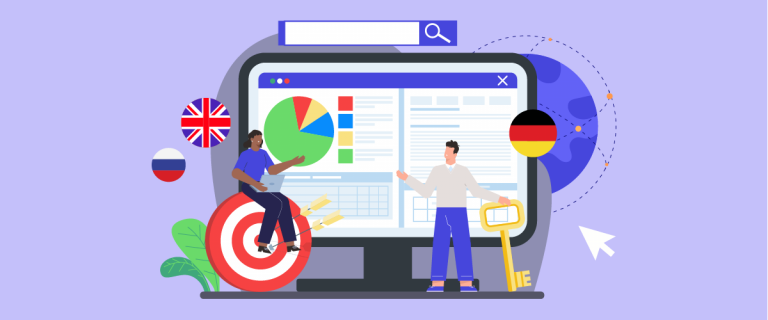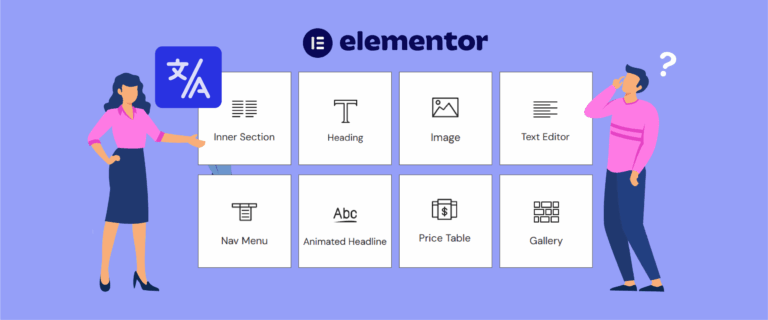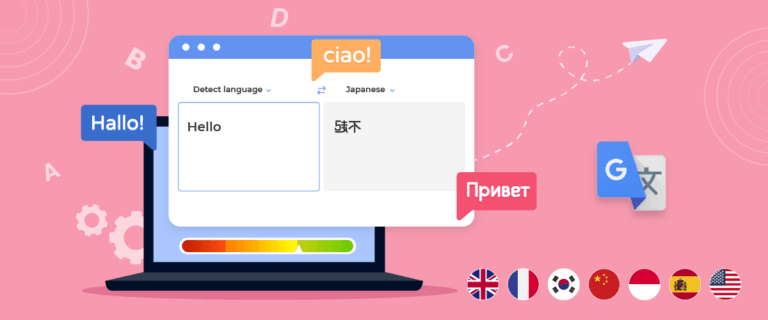Do you have a Shopify store and want to reach global customers? Shopify international SEO is the right answer to expand your online business to the global market. By effectively optimizing your Shopify store for international search engines, you can increase your visibility and attract more customers from around the world.
This article will discuss key factors to optimizing Shopify international SEO, including Linguise, a powerful platform that automates translation and Shopify localization processes. Let’s start!
#1 Choosing international domain structure

One of the most important decisions you’ll face is choosing an appropriate domain structure. This choice significantly impacts how search engines index your site and how users navigate it. Here are some options you can choose from.
Subdirectories (Subfolders)
Subdirectories allow website content to be organized into folders within the main domain. This method is commonly used to target different languages or locations with a clear and straightforward URL structure.
Example Domain:
- Examplestore.com/en/ for English-speaking users
- Examplestore.com/id/ for users in Indonesia
Pros:
Offer stronger SEO signals compared to subdomains and are simpler to manage than ccTLDs. By keeping all content within the same domain, SEO authority is consolidated, potentially speeding up ranking times in search engines.
Cons:
While stronger than subdomains in terms of SEO and still don’t have the geographic targeting strength of ccTLDs, making them less effective for highly specific local strategies.
Subdomains
A subdomain organizes content by using a third-level domain to specify language or country codes, creating a distinct separation from the main domain.
Example Domain:
- es.examplestore.com for Spanish users
- fr.examplestore.com for French users
Pros:
Subdomains are more manageable than ccTLDs. They remain under the main domain but allow for flexible targeting of different countries or categories. This gives you more organizational options without needing to create entirely new domains.
Cons:
Are less effective than ccTLDs in international SEO since search engines often treat them as separate entities. This can dilute domain authority and slow down ranking improvements.
Country Code Top-Level Domains (ccTLDs)
ccTLDs are country-specific domains that end in two-letter codes, indicating that the site is tailored for a particular country’s users.
Example Domain:
- yourdomain.it for Italy
- yourdomain.co.uk for the UK
- yourdomain.de for Germany
Pros:
Provide automatic geographic targeting, making them the most effective SEO strategy for ranking in specific countries. They send a clear signal to search engines about the site’s relevance to a particular audience, simplifying targeting efforts.
Cons:
While powerful for geographic targeting, are not suitable for language targeting and can require more time and resources for maintenance.
By considering your Shopify store’s needs, you can choose the structure that best aligns with your target audience and SEO strategy.
#2 Utilizing hreflang tags to enhance SEO
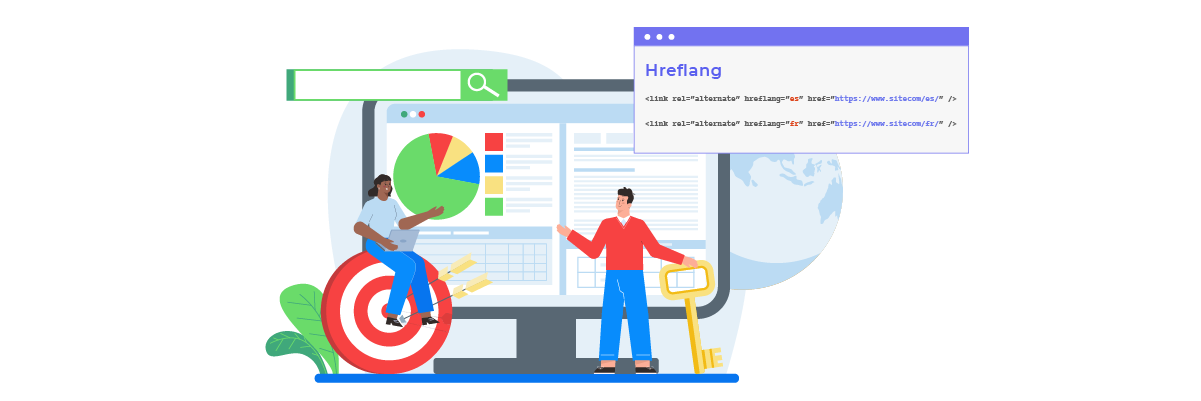
Hreflang tags play a crucial role in international SEO by helping search engines understand which version of your site to display to users based on their language and geographical location. This ensures that your French customers see your French content rather than, say, your Finnish version.
To implement hreflang tags across your entire theme, include code that looks like this in the head section of your HTML.
<head>
<link rel="alternate" hreflang="en" href="mystore.com" />
<link rel="alternate" hreflang="es" href="es.mystore.com /> <script type="application/ld+json" class="gnpub-schema-markup-output">{"@context":"https:\/\/schema.org\/","@type":"NewsArticle","@id":"https:\/\/www.linguise.com\/blog\/guide\/optimizing-shopify-international-seo-creating-multi-language-stores\/#newsarticle","url":"https:\/\/www.linguise.com\/blog\/guide\/optimizing-shopify-international-seo-creating-multi-language-stores\/","image":{"@type":"ImageObject","url":"https:\/\/www.linguise.com\/wp-content\/uploads\/2024\/10\/FI_Optimizing-Shopify-International-SEO-Creating-Multi-Language-Stores-150x150.png","width":150,"height":150},"headline":"Optimizing Shopify International SEO: Creating Multi-Language Stores","mainEntityOfPage":"https:\/\/www.linguise.com\/blog\/guide\/optimizing-shopify-international-seo-creating-multi-language-stores\/","datePublished":"2024-10-08T07:59:07+00:00","dateModified":"2024-10-09T00:43:41+00:00","description":"Optimize your Shopify international SEO for expanding your global customers! Find out key factors and tools for automatic translation","articleSection":"Guide","articleBody":"Do you have a Shopify store and want to reach global customers? Shopify international SEO is the right answer to expand your online business to the global market. By effectively optimizing your Shopify store for international search engines, you can increase your visibility and attract more customers from around the world.This article will discuss key factors to optimizing Shopify international SEO, including Linguise, a powerful platform that automates translation and Shopify localization processes. Let\u2019s start!\t\t\n\t\t\t#1 Choosing international domain structure\n\t\t\n\t\t\t\t\t\t\t\t\t\t\t\t\t\t\t\t\t\t\t\t\t\t\t\t\t\t\n\t\tOne of the most important decisions you'll face is choosing an appropriate domain structure. This choice significantly impacts how search engines index your site and how users navigate it.\u00a0 Here are some options you can choose from.\t\t\n\t\t\tSubdirectories (Subfolders)\n\t\t\n\t\tSubdirectories allow website content to be organized into folders within the main domain. This method is commonly used to target different languages or locations with a clear and straightforward URL structure.Example Domain:Examplestore.com\/en\/ for English-speaking usersExamplestore.com\/id\/ for users in IndonesiaPros:Offer stronger SEO signals compared to subdomains and are simpler to manage than ccTLDs. By keeping all content within the same domain, SEO authority is consolidated, potentially speeding up ranking times in search engines.Cons:While stronger than subdomains in terms of SEO and still don\u2019t have the geographic targeting strength of ccTLDs, making them less effective for highly specific local strategies.\t\t\n\t\t\tSubdomains\n\t\t\n\t\tA subdomain organizes content by using a third-level domain to specify language or country codes, creating a distinct separation from the main domain.Example Domain:es.examplestore.com for Spanish usersfr.examplestore.com for French usersPros:Subdomains are more manageable than ccTLDs. They remain under the main domain but allow for flexible targeting of different countries or categories. This gives you more organizational options without needing to create entirely new domains.Cons:Are less effective than ccTLDs in international SEO since search engines often treat them as separate entities. This can dilute domain authority and slow down ranking improvements.\t\t\n\t\t\tCountry Code Top-Level Domains (ccTLDs)\t\t\n\t\tccTLDs are country-specific domains that end in two-letter codes, indicating that the site is tailored for a particular country's users.Example Domain:yourdomain.it for Italyyourdomain.co.uk for the UKyourdomain.de for GermanyPros:Provide automatic geographic targeting, making them the most effective SEO strategy for ranking in specific countries. They send a clear signal to search engines about the site's relevance to a particular audience, simplifying targeting efforts.Cons:While powerful for geographic targeting, are not suitable for language targeting and can require more time and resources for maintenance.By considering your Shopify store's needs, you can choose the structure that best aligns with your target audience and SEO strategy.\t\t\n\t\t\t#2 Utilizing hreflang tags to enhance SEO\t\t\n\t\t\t\t\t\t\t\t\t\t\t\t\t\t\t\t\t\t\t\t\t\t\t\t\t\t\n\t\tHreflang tags play a crucial role in international SEO by helping search engines understand which version of your site to display to users based on their language and geographical location. This ensures that your French customers see your French content rather than, say, your Finnish version.\u00a0To implement hreflang tags across your entire theme, include code that looks like this in the head section of your HTML.","keywords":"","name":"Optimizing Shopify International SEO: Creating Multi-Language Stores","thumbnailUrl":"https:\/\/www.linguise.com\/wp-content\/uploads\/2024\/10\/FI_Optimizing-Shopify-International-SEO-Creating-Multi-Language-Stores-150x150.png","wordCount":478,"timeRequired":"PT2M7S","mainEntity":{"@type":"WebPage","@id":"https:\/\/www.linguise.com\/blog\/guide\/optimizing-shopify-international-seo-creating-multi-language-stores\/"},"author":{"@type":"Person","name":"Aorinka Anendya","url":"https:\/\/www.linguise.com\/author\/aorinka\/","sameAs":[],"image":{"@type":"ImageObject","url":"https:\/\/secure.gravatar.com\/avatar\/f96846f24c8259f1c8e7eb0342d44ba09f57b51b37a2734d532085b243e2688b?s=96&d=mm&r=g","height":96,"width":96}},"editor":{"@type":"Person","name":"Aorinka Anendya","url":"https:\/\/www.linguise.com\/author\/aorinka\/","sameAs":[],"image":{"@type":"ImageObject","url":"https:\/\/secure.gravatar.com\/avatar\/f96846f24c8259f1c8e7eb0342d44ba09f57b51b37a2734d532085b243e2688b?s=96&d=mm&r=g","height":96,"width":96}}}</script> </head>
This code tells search engines that you have an English version in your main domain and a Spanish version in the ‘es’ subdomain.
For more granular control, you can implement hreflang tags on specific pages like product pages or collections:
<head>
<link rel="alternate" hreflang="en" href="mystore..com/products/{product-name}" />
<link rel="alternate" hreflang="es" href="es.mystore/products/{product-name}" /> <script type="application/ld+json" class="gnpub-schema-markup-output">{"@context":"https:\/\/schema.org\/","@type":"NewsArticle","@id":"https:\/\/www.linguise.com\/blog\/guide\/optimizing-shopify-international-seo-creating-multi-language-stores\/#newsarticle","url":"https:\/\/www.linguise.com\/blog\/guide\/optimizing-shopify-international-seo-creating-multi-language-stores\/","image":{"@type":"ImageObject","url":"https:\/\/www.linguise.com\/wp-content\/uploads\/2024\/10\/FI_Optimizing-Shopify-International-SEO-Creating-Multi-Language-Stores-150x150.png","width":150,"height":150},"headline":"Optimizing Shopify International SEO: Creating Multi-Language Stores","mainEntityOfPage":"https:\/\/www.linguise.com\/blog\/guide\/optimizing-shopify-international-seo-creating-multi-language-stores\/","datePublished":"2024-10-08T07:59:07+00:00","dateModified":"2024-10-09T00:43:41+00:00","description":"Optimize your Shopify international SEO for expanding your global customers! Find out key factors and tools for automatic translation","articleSection":"Guide","articleBody":"Do you have a Shopify store and want to reach global customers? Shopify international SEO is the right answer to expand your online business to the global market. By effectively optimizing your Shopify store for international search engines, you can increase your visibility and attract more customers from around the world.This article will discuss key factors to optimizing Shopify international SEO, including Linguise, a powerful platform that automates translation and Shopify localization processes. Let\u2019s start!\t\t\n\t\t\t#1 Choosing international domain structure\n\t\t\n\t\t\t\t\t\t\t\t\t\t\t\t\t\t\t\t\t\t\t\t\t\t\t\t\t\t\n\t\tOne of the most important decisions you'll face is choosing an appropriate domain structure. This choice significantly impacts how search engines index your site and how users navigate it.\u00a0 Here are some options you can choose from.\t\t\n\t\t\tSubdirectories (Subfolders)\n\t\t\n\t\tSubdirectories allow website content to be organized into folders within the main domain. This method is commonly used to target different languages or locations with a clear and straightforward URL structure.Example Domain:Examplestore.com\/en\/ for English-speaking usersExamplestore.com\/id\/ for users in IndonesiaPros:Offer stronger SEO signals compared to subdomains and are simpler to manage than ccTLDs. By keeping all content within the same domain, SEO authority is consolidated, potentially speeding up ranking times in search engines.Cons:While stronger than subdomains in terms of SEO and still don\u2019t have the geographic targeting strength of ccTLDs, making them less effective for highly specific local strategies.\t\t\n\t\t\tSubdomains\n\t\t\n\t\tA subdomain organizes content by using a third-level domain to specify language or country codes, creating a distinct separation from the main domain.Example Domain:es.examplestore.com for Spanish usersfr.examplestore.com for French usersPros:Subdomains are more manageable than ccTLDs. They remain under the main domain but allow for flexible targeting of different countries or categories. This gives you more organizational options without needing to create entirely new domains.Cons:Are less effective than ccTLDs in international SEO since search engines often treat them as separate entities. This can dilute domain authority and slow down ranking improvements.\t\t\n\t\t\tCountry Code Top-Level Domains (ccTLDs)\t\t\n\t\tccTLDs are country-specific domains that end in two-letter codes, indicating that the site is tailored for a particular country's users.Example Domain:yourdomain.it for Italyyourdomain.co.uk for the UKyourdomain.de for GermanyPros:Provide automatic geographic targeting, making them the most effective SEO strategy for ranking in specific countries. They send a clear signal to search engines about the site's relevance to a particular audience, simplifying targeting efforts.Cons:While powerful for geographic targeting, are not suitable for language targeting and can require more time and resources for maintenance.By considering your Shopify store's needs, you can choose the structure that best aligns with your target audience and SEO strategy.\t\t\n\t\t\t#2 Utilizing hreflang tags to enhance SEO\t\t\n\t\t\t\t\t\t\t\t\t\t\t\t\t\t\t\t\t\t\t\t\t\t\t\t\t\t\n\t\tHreflang tags play a crucial role in international SEO by helping search engines understand which version of your site to display to users based on their language and geographical location. This ensures that your French customers see your French content rather than, say, your Finnish version.\u00a0To implement hreflang tags across your entire theme, include code that looks like this in the head section of your HTML.","keywords":"","name":"Optimizing Shopify International SEO: Creating Multi-Language Stores","thumbnailUrl":"https:\/\/www.linguise.com\/wp-content\/uploads\/2024\/10\/FI_Optimizing-Shopify-International-SEO-Creating-Multi-Language-Stores-150x150.png","wordCount":478,"timeRequired":"PT2M7S","mainEntity":{"@type":"WebPage","@id":"https:\/\/www.linguise.com\/blog\/guide\/optimizing-shopify-international-seo-creating-multi-language-stores\/"},"author":{"@type":"Person","name":"Aorinka Anendya","url":"https:\/\/www.linguise.com\/author\/aorinka\/","sameAs":[],"image":{"@type":"ImageObject","url":"https:\/\/secure.gravatar.com\/avatar\/f96846f24c8259f1c8e7eb0342d44ba09f57b51b37a2734d532085b243e2688b?s=96&d=mm&r=g","height":96,"width":96}},"editor":{"@type":"Person","name":"Aorinka Anendya","url":"https:\/\/www.linguise.com\/author\/aorinka\/","sameAs":[],"image":{"@type":"ImageObject","url":"https:\/\/secure.gravatar.com\/avatar\/f96846f24c8259f1c8e7eb0342d44ba09f57b51b37a2734d532085b243e2688b?s=96&d=mm&r=g","height":96,"width":96}}}</script> </head>
Best practices for effective implement hreflang tags.
- Link all language versions of a page, including self-referential links
- Use precise ISO language codes, including regional variants when applicable
- Ensure hreflang tags are placed in the <head> section of your HTML
- Include an x-default hreflang tag for language/region selector pages
- Regularly audit your hreflang implementation to catch and fix any errors
#3 Adapting content and keywords to suit various markets

Localizing content and keywords is a crucial aspect of international SEO that goes far beyond mere translation. Cultural differences significantly impact purchasing behavior, and what works in one market may fall flat in another.
For instance, German consumers often require more detailed product information compared to their US or UK counterparts. This underscores the need for market-specific research to identify local search trends and user preferences.
Here’s how to approach content localization effectively.
- Utilize local SEO tools and resources, including the “People also ask” section of search engine results pages (SERPs) to identify relevant keywords in each target market. Analyze your local competitors and their keyword strategies, paying attention to the tags they use for products and descriptions.
- Adapting your content to local preferences requires tailoring it to resonate with the local audience, considering language nuances and cultural references. Use local idioms or references when appropriate to make your content more relatable. However, it’s crucial to maintain your brand voice while adapting content for different markets.
- Prioritize high-impact pages, such as product descriptions, landing pages, and customer reviews. These are the types of content that directly impact conversions and revenue. Consider creating market-specific content that addresses local concerns or preferences.
- Track and analyze the performance of localized content using key metrics such as organic traffic, conversion rates, and user engagement specific to each market. Use tools like Google Analytics to segment data by country and language. This data will allow you to optimize your content based on performance continuously.
#4 Handling multi-currency pricing and international payment systems
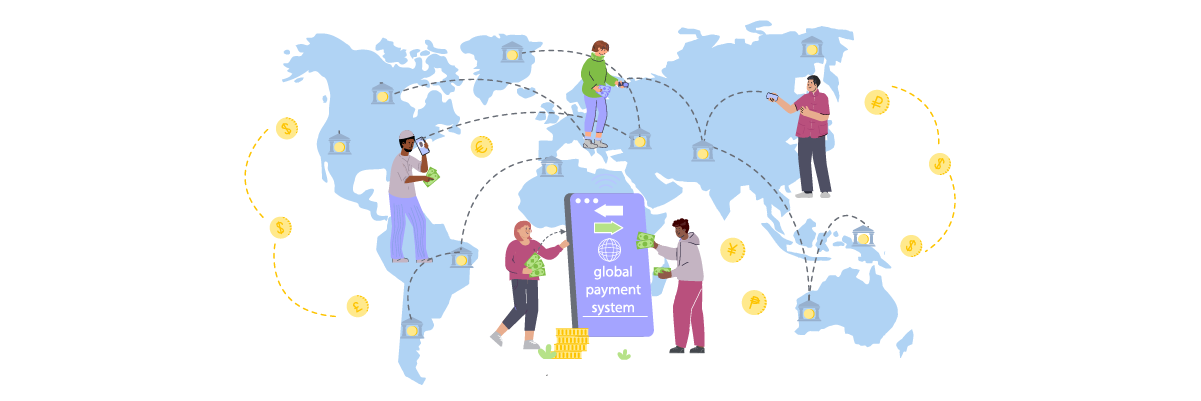
Managing multi-currency pricing and international payments is a crucial aspect of global e-commerce. Here are some ways to set up and provide multi-currency options for international customers. How to enable Shopify Payments for multi-currency transactions.
- Activate Shopify Markets: Activate and adjust your currency settings accordingly. Then, set up bank accounts for each currency you wish to support
- For multi-currency pricing: Set appropriate conversion rates for each currency and display the prices using either currency selectors or geolocation features. Consider round prices for psychological impact in each currency.
- Managing international payments: Integrate diverse payment gateways, such as PayPal, Stripe, or other local providers, and offer various payment options to meet customer preferences. Research the most popular payment methods in your target markets.
#5 Providing multilingual customer support

Multilingual customer is one of the key factors of successful international e-commerce. It demonstrates a genuine commitment to your global customers and can significantly enhance their experience with your brand. This approach shows that you understand and respect the cultural nuances and preferences of your diverse customer base, which can lead to increased customer satisfaction, higher retention rates, and positive word-of-mouth marketing in various regions.
Implementing effective multilingual support requires more than just hiring bilingual staff or using translation tools. It involves creating a comprehensive strategy that considers the unique needs and expectations of customers from different linguistic and cultural backgrounds. This might include offering support across various channels (e.g., email, live chat, phone, social media) in multiple languages, developing region-specific FAQs and knowledge bases, and ensuring that your support team is not only linguistically proficient but also culturally sensitive.
Best practices for implementing multilingual customer support include:
- Prioritize languages based on your target markets: Focus on the languages spoken in your key international markets rather than trying to cover every language from the start.
- Hire native speakers: Whenever possible, employ support staff who are native speakers of the languages you’re targeting. They’ll understand cultural nuances and idioms that non-native speakers might miss.
- Provide 24/7 support: Consider time zone differences and aim to offer round-the-clock support for your most important markets and languages.
- Develop multilingual self-service options: Create comprehensive FAQs, knowledge bases, and video tutorials in multiple languages to empower customers to find solutions on their own.
- Integrate multilingual support with your CRM: This allows you to track customer interactions across languages and provide personalized support based on a customer’s history and preferences.
#6 Developing local backlinks and directory listings

Building a strong network of local backlinks is one of the most effective ways to boost your visibility in specific regions. These backlinks not only drive targeted traffic to your site but also build trust within local communities. Implementing a comprehensive local backlink strategy requires a multi-faceted approach.
- Create high-quality local content: produce content resonating with local audiences, develop blog posts, articles, and multimedia addressing local interests, create local guides and community-focused content
- Engage in guest blogging and collaborations: partner with reputable local websites for guest posting, seek collaborations with non-competing local businesses and ensure guest posts provide value to the host site’s audience.
- Participate in local community events: sponsor or participate in local events to earn mentions and backlinks and engage in community activities to enhance brand visibility.
- Partner with local organizations: Form partnerships with local charities, non-profits, and schools, offer support or sponsorship in exchange for backlinks, and engage in joint initiatives for press coverage and backlinks.
#7 Simplifying cross-border shipping and tax regulations

Navigating the complex landscape of cross-border shipping and tax compliance is one of the most challenging aspects of international e-commerce. However, streamlining these processes can lead to significant cost savings, improved customer satisfaction, and a competitive advantage in the global marketplace.
Here are some options you can take to deal with shipping regulations and taxes.
- Choose the right shipping partner: Different regions may require different shipping methods or carriers. Research and choose a shipping partner that has expertise in your target market. Transparency in shipping costs and delivery times is essential to building trust with international customers.
- Understand and comply with international tax laws: Each country regulates import duties, value-added tax (VAT), and goods and services tax (GST). Stay informed about these regulations in your target markets, and make sure your pricing and checkout processes account for these additional costs.
- Calculate taxes automatically: Shopify provides built-in tools for managing international shipping and tax compliance, which can significantly simplify this process. Shopify can and duties for different regions, taking into account factors such as product type, shipping destination, and order value.
- Stay informed about trade agreements between countries: For example, the United States-Mexico-Canada Agreement (USMCA) affects trade among North American countries, potentially reducing cross-border e-commerce costs in this region.
#8 Using automatic & accurate translation
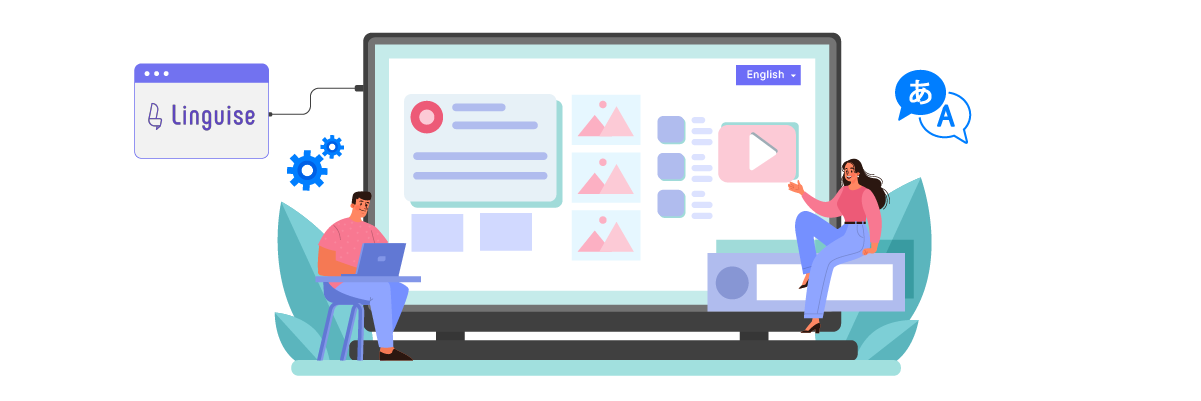
Shopify international SEO is very useful for your Shopify store, but it is also quite complex. Therefore, there is a need for a system that can automate various aspects of international SEO, one of which is the shop translation aspect.
Linguise is an automated website translation that also integrates seamlessly with Shopify.
Linguise feature for Shopify store
Here are some of the Linguise features that Shopify international SEO supports
- Fast translation: able to translate all Shopify content quickly and accurately, from content product descriptions to image translation.
- Integrate and easy setup: It seamlessly integrates with Shopify. With just a few steps, your Shopify can be automatically translated.
- Easy localization with live editor: You can edit the auto-translation results, collaborate with local translators, and customize it to suit local audiences.
- Automatic Shopify international SEO: Linguise supports SEO optimization for Shopify, including automatic hreflang, canonical, meta description translation, multilingual sitemap, and more.
- Unlimited languages and free plan: you can try the 30-day free trial feature and access unlimited added languages on your Shopify store.
- Customizing language switcher: you can add language switch options and customize them as needed.
Optimizing Shopify International SEO using Linguise!
Shopify international SEO is your key to accessing global customers. By implementing the strategies outlined in this article, you can effectively reach new audiences and expand your Shopify store’s reach. Remember, a crucial aspect of international SEO is ensuring accurate and culturally relevant content for your target markets.
This is where Linguise can help. This powerful platform seamlessly integrates with Shopify, automating translation processes and streamlining localization efforts. So, what are you waiting for? Create a Linguise account for your Shopify store!

